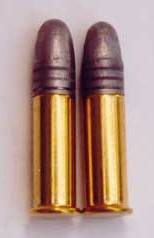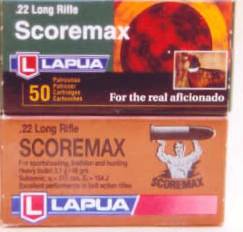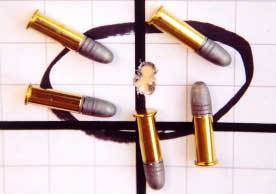|
What characteristics should good rim fire ammunition have? Well, my personal
first criteria for any ammo, no matter the type, is accuracy. Iíve always said
that "First you have to hit the target, then, and only then, you can start
worrying about whether it will fall down or not".
My second criteria is cost. I think most people have a natural
tendency to shoot more rim fire ammo than any other type. Convenience is
probably the primarily reason for this. The ammo is already assembled and ready
to go so all we have to do is open the box and start stuffing them in.
Consequently, thereís no personal sweat factor involved as there is when
reloading center fire ammo.
Lack of recoil, is probably another big reason why most shooters tend
to use more rimfire ammo that any other type. Itís just so mild and easy to
shoot we can totally concentrate on the shot without any consideration of any
personal discomfort. We can fire dozens of shots and not even be aware weíre
doing it. Not so with center fire ammo. Every shot makes its presence well known
- some times very well known. Subsequently, considering that weíre probably
using a lot more rimfire ammo than other types, cost becomes a very practical
consideration.
The last criteria that I use is knockdown. With first class
commercially made silhouette targets and straight and even target rails,
knockdown isnít usually a problem, although a ram will, from time to time, fail
to fall - even when well hit. However, not all clubs can afford the luxury of
having absolute fool proof targets and rails and have to get by with home made
animals made from whatever materials that are available. Knockdown and target
quality is always a consideration.
As you know, over the last year or two, Iíve come to appreciate the
qualities of Lapua ammunition, especially as an alternative to the other well
know brand of target ammunition. Like the other guy, Lapua has a ton of choices
for every conceivable shooting situation. Itís always nice to have choices, but
on the other hand, the perfect ammunition that exactly fills all of our
requirements can get lost in the crowd. I think this is exactly the situation
that describes Scoremax. While many silhouette shooters are familiar with
Lapuaís Club, Super Club, and the premium Midas, Scoremax is an unknown factor
to many people. This is unfortunate, as I believe that Scoremax, from a
performance standpoint, may just be the perfect rimfire silhouette ammunition.
The primary characteristic that distinguishes Scoremax from all other
rimfire ammo is the fact that is uses a 48-grain bullet versus the standard 40
grainer. When I first became aware of that fact, I assumed that the purpose of
the heavier bullet was for hunting purposes. Indeed, the 48 grain bullet is
significantly more effective on game than your run of the mill rim fire bullet.
However no matter how useful for hunting, Scoremax is primarily a match grade
target type ammunition with a secondary application for hunting.
|
 |
|
Notice the subtile
differences in the Scoremax bullet on the left and the standard 40 grain
bullet on the right. |
|
OK, so what is the real purpose of the heavier bullet? Scoremax was
designed at the outset to be a LONG RANGE rim fire target ammunition i.e. from
50 to 100 yards. Most rimfire competition takes place at 25 or 50 yards, and
consequently almost all rim fire ammunition is designed for maximum
effectiveness at those distances and no farther. In fact, in Europe, a lot of
the rim fire competition takes place indoors where range distances are naturally
limited. On the other hand, Scoremax is designed to be optimally effective out to
100 yards and even more and in conditions of less than perfect weather.
So how can a heavier bullet contribute to better long-range
performance? Within a given diameter, a heavier bullet is going to be a longer
bullet, and a longer bullet will have a better ballistic coefficient than a
bullet that is not as heavy/long. A longer bullet will therefore be more
aerodynamically efficient and will lose less velocity over long ranges. The
result is that the Scoremax bullet will not only be delivering more weight on
the target rams but it will be delivering it at a higher velocity than a
standard target grade bullet. At a 100 yards, the improved BC provides an
advantage.
Putting a longer, heavier bullet in a standard length rim fire case
presented Lapua with a technical challenge. After all, a longer bullet might not
work as well in standard 1: 16 twist barrels that most firearms manufacturers
use. Plus the cartridge would have to work in standard and target chambers whose
dimensions are spelled out by SAAMI and other similar organizations.
Consequently, the decision was made to put
most of the additional weight in the heel of the bullet i.e. the part thatís
inside the case that you canít see. The design of the heel is the same as that
used on Lapuaís Midas premium ammo, only just a bit longer. Since the heel of
the bullet does not engage the rifling, the bearing surface of the bullet is
left largely unchanged and so its ability to be properly stabilized in a
standard twist barrel is unchanged as well.
|
 |
|
Scoremax's
packaging has recently been updated but the ammo is the same. |
|
Another part of the weight gain comes from the fact that a less
tapered, more rounded nose is used. This ogive is actually the same ogive that
was used on Lapuaís very successful "Championship" ammunition, which was made in
the 60ís, 70ís, and 80ís. While some may criticize Scoremaxís less streamlined
nose, the simple fact is that at subsonic velocities, nose shape is not as
important a factor as it is at supersonic velocities.
Indeed, Scoremaxís velocity is rated at 1032 fps. With the longer
bullet being subsonic, it means there will be less bullet drag and that means
weíll experience less velocity drop, less wind drift, and it will hit harder at
extended ranges. When the wind is blowing, and it always is, this is the
ammunition you want to use.
OK. Thatís the theory part, but what about real world performance?
Well, there was only one way to find out. I grabbed a box of Scoremax, my
chronograph, and my 26-inch Winchester 52. I also brought along a box of PMC
Match Rifle ammo for comparison. The PMC is loaded with a standard 40-grain
bullet. In Step One the plan would be to chronograph each ammunition at the
muzzle and record the results. In Step Two, I would then walk my chronograph out
to one hundred yards and repeat the process and compare the results. The
improved ballistic coefficient of the longer, heavier bullet should result in
less velocity drop at that distance. Here are the results.
|
Muzzle Velocity |
100 Yard Velocity |
Velocity
Drop |
|
Scoremax |
1046 fps |
956 fps 90 fps |
|
PMC Match Rifle |
1036 fps |
936 fps 100 fps |
Theory was correct! Scoremax was 10 fps faster at the muzzle and ended
up 20 fps faster than the 40-grain bullet at 100 yards. Even though our "common
sense" tells us that a heavier bullet should be slowing down faster than an
lighter bullet, we see that the heavier/longer bullet is indeed more efficient.
So, at 100 yards the Scoremax bullet will go faster while putting more weight on
the target. That means more knockdowns any way you slice it.
|
 |
|
Scoremax is capable of
producing very impressive results. |
|
Ok. What about accuracy. I donít say this very often but the ammo will
shoot as well as you can hold. The group in the photo was shot at 50 yards with
a Thompson Contender equipped with a Bullberry match barrel. My Burris 8 X 32
provided the optics. Four shots went into exactly the same hole. The
fifth shot went into the group just slightly below the first four making a
somewhat elliptical hole overall. Overall group size was scant .168". I was
definitely pleased with the results.
How about price? This ammo falls in what I would call the middle price
range. It can be found for around $5.25 to $6.50 a box, so shop around. Itís not
cheap, but itís definitely not in the $10 a box range either, although it does
shoot like the ten-buck stuff.
|
Accuracy - 10 |
|
Price - 7 |
|
Knockdown - 10 |
So how does Scoremax meet our three criteria? On a scale of one to
ten, with ten being the top mark, hereís how I would grade it.
Considering its first class accuracy, its down range performance, and
its ability to shoot better in the wind, itís well worth the price. I like this
stuff so much; Iím buying more - a lot more, as in a case more. Just try one box
and see what you think.
|
![]()